-
Paper Information
- Paper Submission
-
Journal Information
- About This Journal
- Editorial Board
- Current Issue
- Archive
- Author Guidelines
- Contact Us
Architecture Research
p-ISSN: 2168-507X e-ISSN: 2168-5088
2021; 11(1): 22-29
doi:10.5923/j.arch.20211101.03
Received: Mar. 22, 2021; Accepted: May 7, 2021; Published: May 28, 2021

The Impact of Ecological Factors of Urban Morphology of Traditional Settlements in African Sahara City
Chouaib Guerrout 1, Bahar Baser Kalyoncuoglu 2
1Department of Architecture, Okan University, Istanbul, Turkey
2Department of Urban Design and Landscape Architecture, Istanbul Medipol University, Istanbul, Turkey
Correspondence to: Chouaib Guerrout , Department of Architecture, Okan University, Istanbul, Turkey.
| Email: |  |
Copyright © 2021 The Author(s). Published by Scientific & Academic Publishing.
This work is licensed under the Creative Commons Attribution International License (CC BY).
http://creativecommons.org/licenses/by/4.0/

Ecological urbanization theories have developed in industrial societies to of finding solutions to environmental problems, but they have not considered the south of the world, which suffers from many problems resulting from global climate changes. Africa is one of the most important continents affected by these changes. Over many years the human population developed in the sub-Saharan Africa and created a very special ecosystem. This system is a lesson from which we can learn many principles of urban ecology. This paper aims to determine the ecological factors in the traditional settlements of African desert. Through the case study, which is the city of Adrar, southern Algeria. the study aims to determine the ecological aspect in the KSAR urban pattern morphology, (KSAR; casbah; traditional house; palm grove) by examining the factors of modern ecological theories, the research paper is divided into two parts. The first part is a morphological analysis of the KSAR urban pattern; The second part is to extract the ecological principles related to the morphological dimension of KSAR, which could be the most effective, for Ecological city, in the African Saharan region.
Keywords: Ecological urbanism, Urban morphology, Ecological memory, Traditional settlements, Ksar, Foggara
Cite this paper: Chouaib Guerrout , Bahar Baser Kalyoncuoglu , The Impact of Ecological Factors of Urban Morphology of Traditional Settlements in African Sahara City, Architecture Research, Vol. 11 No. 1, 2021, pp. 22-29. doi: 10.5923/j.arch.20211101.03.
Article Outline
1. Introduction
- Architecture in the African Desert is the result of a range of social, environmental, and economic factors during a well-defined historical period. This environment is the result of an ongoing process involving community capabilities on pregnancy, planning and construction and maintaining themselves in this arid geographical space. Thus, this architecture is concrete space must be reference to all future achievements. In this part of the research, we are trying to identify environmental factors to the built-in framework in the traditional urban tissue in Adrar City through the construction of topology and factors related to population, culture, and the environment. The urban morphology in desert architecture is not a result of coincidence but rather the result of man benefiting from realistic experiences. The knowledge gained from these experiences can be actual lessons to be used in our perception of the morphology of future cities in this difficult environment. “In an obvious way, human societies are spatial phenomena they occupy regions of the earth's surface, and within and between these regions material resources move, people encounter each other and information is transmitted”. [1]
2. Problems
- The aim of urban and architectural research in the field of African desert cities is to develop human life in these areas.Many theories of sustainability express the extent of their environmental, social, and economic interests in cities, but these theories, when applied in a different geographical framework from the cities in which these theories were developed, show their weakness in the face of ecological, economic, and social needs.Urban or architectural morphology is an important physical result of human practices within a geographical area.It clearly expresses the economic and environmental culture of the society.When these forms are changed according to theories imported from outside the original geographical area, this is a clear problem within cities. Therefore, we need to understand the performance of urban morphology and its ecological importance at the urban and architectural level to benefit from it in our perceptions of future cities in the Sahara of Africa.
2.1. Why This Subject?
- Architecture in desert cities is distinguished by its simplicity and lack of aesthetics, but we can draw many lessons about its strength in domesticating difficult nature and preserving resources in an area where it is virtually non-existent.The human need in these areas for a normal life, he developed a knowledge of dealing with ecological characteristics, where he tried in a rational way to provide his cultural, ecological, and economic needs through urban and architectural techniques.This knowledge needs a scientific reading that enables us to re-develop and reuse it.
2.2. Why This Subject is Important
- The African Sahara represents a third of the area of Africa and more than the area of China, but unfortunately this region remains one of the poorest regions in the world and the most affected by environmental problems and diseases. The ecological urbanization is one of the most important areas that can achieve for us more sustainable cities and reduce the impacts Population growth, urban sprawl, climate changes, and all the ecological problems that the world lives today.Therefore, the study of ecological development in the African Sahara may be the most important solution for this region in the world, so we need more accurate scientific studies.
2.3. Why the Ksour of ADRAR?
- KSOUR desert cities arose along the trade routes between the north and south of the African continent, where economic and social life developed in these centers.Over many years KSOUR has evolved into Oasis Systems and FOGARA Watering Systems.The oasis system is considered a sustainable system that needs a deep understanding to extract ecological knowledge and its reuse.
2.4. Hypothesis and Objective
- The study aims to highlight the importance of the impact of ecological factors on urban morphology in the traditional settlements in the African Sahara.We can ask the question if the urban form used certain techniques through its various architectural levels in the urban system, casbah and housing to achieve ecological benefits? If so, what are these technics and what is their specificities? How can they be explained? Our hypothesis states that if there is technics and specificity, it is not just a morphological concern. Can be identified this benefit of technics and specificities and what are their advantages?
3. Definition of the Concept
- “Urban morphology in simple terms is the scientific study of urban form.” [1] The objective of the morphological analysis is to understand the relationships between the physical components of a city’s urban system. Our analysis focuses on the ancient city urban physical form, spatial structure, and character of the city through four main components of urban form that apparently signifies the form of the urban fabric [2] which are: (i) Buildings (or constructed space); (ii) Plots or lots; (iii) Streets and (iv) Open space. [3]Urban fabric is a fundamental small-scale component of urban form with important relations to social, economic or environmental phenomena. [2]. To simplify complications in the urban system, to understand relations between different components, the decomposition process is very important for more realistic analysis.
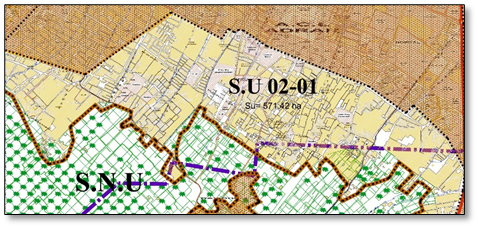 | Figure 1. Location of casbah of Adghagh in traditional settlement of Adrar city |
3.1. Presentation of the Studied Space
- The wilaya of Adrar covers an area of 427,968 KM2, or almost 18% of the National territory, for a population estimated at 443,936 inhabitants at 31.12.2012. The density is 1.04 inhabitants / km2. It has four distinct natural units: the Gourara in the north of which the city of Timimoun is the main city, Tidikelt in the Southeast framed by Aoulef, Tanezrouft around the region of Bordj Badji-Mokhtar and in the middle the Touat where the grouping of Adrar and Timmi is located, as the main agglomeration of the wilaya.
3.2. Methodology
- The method of analysis used is based on the morphological analysis of a part of the old city in the urban centre of Adrar."Every science has for its object a morphology" [1] The analysis process depends on the decomposition of the urban system into four subsystems, which are the Plot System, the Road Network System, the Buildings System and the Open Space System.These subsystems are then analysed into three aspect.Geometric aspectDimensional aspect Topological aspect Next, we try, using an analytical matrix, to extract and analyse the ecological characteristics of each aspect at the urban and architectural level (the Casbah and the residences).
3.3. Interest of The Decomposition
- “The city-classes are generally characterized as mixed classes consisting of numerous sub features” [3] The method we propose is intended, on the other hand has decaying urban system in "systems", a system being defined by the way are organized the relationships between the components of the same morphological type. For example, the fragmented system is!' all relations between the plots and the road system is the set of relationships between the streets.The morphological lecture will help us to identify the composition principles of the Kasbah. This reading also allows us to orient the intervention operation and serve as an instrument to delimit and define the intervention sectors.According to the casbah survey There are 14 dwellings in this casbah with a very homogeneous configuration. The building has high, almost blind walls on the outside, with "Borja" towers at the corners.
4. Analysis Approaches
- The four organizers’ systems of the urban system
4.1. The Plot System
- “The importance of the plot (also referred to as ‘property’) as one of the fundamental elements of urban form.” [4]the plot system is a system of partition of space of the territory in a few land units, the plots. The plot therefore fragments the territory. Geometric: The regular shape (rectangle / square) confirms that the Kasbah is a creation.Topological: the plots have divided into 06 large plot.Dimensional: The dimensional aspect of the plots distinguishes the time of construction (build at the same time) The dimensions allow us to make a social reading on the inhabitants (the social value there is a social balance).
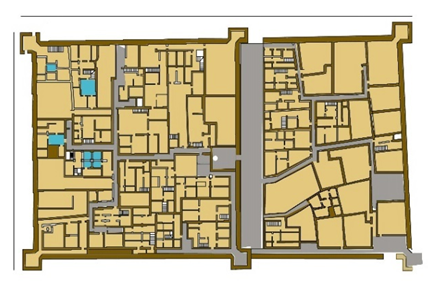 | Figure 2. Casbah adghagh Adrar city |
4.2. The Roads Network System and Built System
- "The road network as a representation of public space is considered as the core generator of the vitality of the region as explained." [5] the road system is the binding of the space of the territory system. It is made by set of variable circulations of function and importance. This network is intended to present the plots, gives to interlink the different parts of the territory. In principle, but this rule suffers few exceptions, each parcel is served by a flow. The front door opens under this covered passage and has a raised threshold. After crossing the chicane corridor, we discover a long distribution passage, horizontal communications on the corners of the houses and at the ends of the Casbah.It is an Arborizing system in the end of the bag. Orthogonal encounter: In this context the hierarchy has not changed because the paths have the same character.“The urban fabric in the of older city in Middle East and Northern Africa has changed drastically over the centuries. The medieval Islamic cities in the region had an organic urban fabric which exhibited a high degree of cultural identity and unity. However, the modern overall urban fabric of these cities reveals no cultural identity, continuity, or unity. The urban fabric is composed of several fragments: the historic core with a vast Islamic architectural and planning heritage, the colonial quarters, the urban development built in the post-colonial era, and the squatter settlements. Each fragment presents a different physical character and a separate social and economic environment”. [6]Built system includes all the masses constructed urban form, regardless of their function (housing, equipment) to their dimension. It is the system that brings together all the built masses.The geometry: There is a great homogeneity between the frame and the plot in all the geometric shapes only the singular elements like - the towers - the surrounding walls. The dimension: In the fabric of the casbah there is a great dimensional homogeneity of system except the mosque and the medersas.
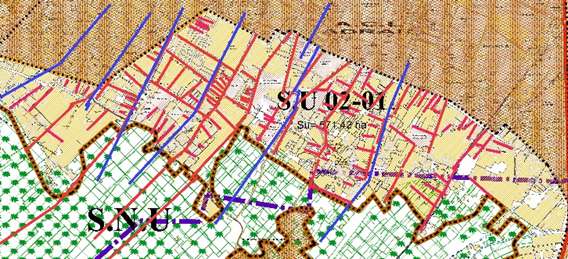 | Figure 3. Plot system |
4.3. Open Space System
- "Urban open spaces are integral parts of city life to provide better quality of life." [7]Open space system is all the parts not built urban form, that these spaces are public (squares, plazas, streets, etc.) to the private (courses, gardens).The open spaces have regular geometry (square /rectangle) located in the centre of houses generally.1/3 of each dimension of the boundaries of each parcel.The combination of the different systems.The combination of the different systems should not believe that each of these systems has a total autonomy of structure to others. What are considering the urban tissue, there are indeed some modes of coupling or privileged certain types of overlay.
 | Figure 4. Road system in adghagh casbah |
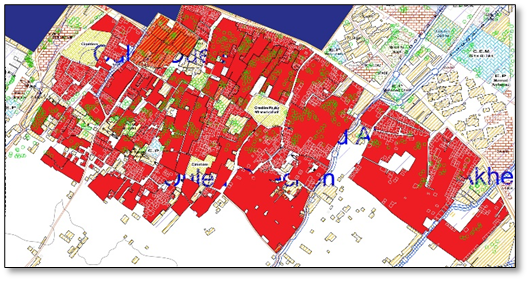 | Figure 5. Traditional building system Adrar city |
5. Results and Discussion
5.1. Ecological Factor in Ksar Urban Pattern
5.1.1. Ecological Factors of Urban Morphology of Traditional
- Table in annex.
5.1.2. The Ksar Orientation
- The main streets of the KSAR are directed from the northeast to the southwest to take advantage of (humid) winds and exchange shade and sunlight in the streets. As for the façades, they are huge and are oriented towards north and south in general. The northern façades are not sunny, but the southern façades can be shaded. The strategic location of the KSAR contributed to obtaining fresh air (it is located next to Palm grove), which is why energy conservation and sustainability are achieved.
5.1.3. Ksar Urban Morphological Structure
- The ksar consists of many Kasbahs, and each area has its own mosque, its own courtyard, and its own social fabric. Each tribe had its own population distribution based on social harmony. The extension is based on reviving the land - the land has no material value. Everyone wanted to build their own home, they could, but the process had guidelines like the necessity of building.“Ksar as Kasbah is a housing stronghold built in clay. But while Kasbah is conceived as an autonomous cell, Ksar is more “generous”. [8]
5.1.4. Urban Fabric
- The Ksar consists of a connected urban fabric of several compact areas that achieve economy in the land, self-sufficiency, and social perseverance, according to environmental conditions. The combined fabric contributed to the shading of the entire The Ksar and realized that various amenities could be easily accessed. The KSAR realizes the most important principles of sustainability (social interaction, integrated use of the land, local independence economics of the land, improvement of environmental conditions).
 | Figure 6. Urban texture in Adrar ksar |
5.1.5. Multi Functionality
- Homes make up most of the entire area in the KSAR, but the remaining space is a few commercial and service locals. The upper floor is used as a living space in various seasons. The KSAR includes a lot of public facilities such as a mosque. This means that the KSAR has realized an important knowledge that sustainable development focuses on, which is (land use integration). This principle is one of the principles of green infrastructure and sustainable urban planning, as many economic, social, and environmental jobs and services are integrated in the same space. “A landscape is regarded as a geographic entity with obvious visual features composing a mix of local ecosystem or land use types, which is able to provide multiple functions”. [9]
 | Figure 7. Religion meeting |
5.1.6. Capacity of Supporting
- Sustainable development focuses on small agglomerations, which are commensurate with the resources available in an area using land and water for agricultural areas. We find this principle in the KSAR wherever it is established as a type of aggregation instead of isolated areas. “The Carrying Capacity Concept has significant practical implications for a balanced relationship between human development and the environment.” [10]
5.1.7. The Social Factor and Connectivity
- The space organization of the ksar through the allocation of places for sitting, meeting and ceremonial squares is the result of the integration of social and cultural values, and the presence of many squares and intersections in front of the living and basic facilities that achieve brotherhood and harmony among the inhabitants of all this gave a strong sense of belonging and complete security.” Connectivity of social-ecological systems promotes resilience across urban landscapes. Community gardens are social-ecological systems that support food production, social interactions, and biodiversity conservation.” [11]
5.1.8. Harmony of Space (Social and Cultural Principles)
- The road network in the KSAR is a physical urban expression of the population's background through a set of data such as privacy (from public to private) and security through vacancies used in social and religious events and activities. You can move from the private space to the public space through a semi-private space using a road network that considers the religious and cultural side. The authorities do intervene to help. All these principles operate as a concept.
5.1.9. Auto -Sufficiency
- One of the most important principles of sustainability is that cities must ensure the minimum level of sufficiency, as they must be independent through their natural resources, energy, and raw materials, which is what the ecosystem in the old city does.
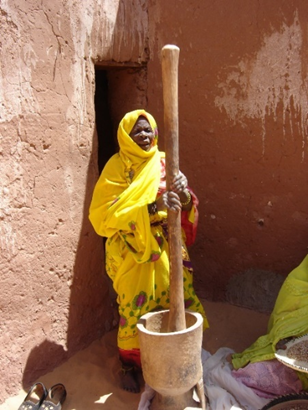 | Figure 8. Home women food production work |
5.1.10. Environmental and Ecological Compatibility
- Sustainability is considered an original and important factor in the KSAR, as the culture of sustainability was imposed on the population in their urbanization and way of life through environmental compatibility and the better exploitation of natural environmental resources represented in:Link to green open spaces: Access to oases and gardens is a simple reason for the possibilities created through the links between green open spaces and the KSAR.Natural ethics for preventing pollution: The common morphology of the KSAR, the nature of the buildings directed towards the interior and the walls surrounding the KSAR and the gardens.Narrow, covered streets, and cultivated inner courtyards also reduce pollution. Natural uses in lighting, ventilation, and air conditioning: the organized layout of the mansion, the streets, the outdoor spaces (spaces), the indoor playgrounds, the use of local building materials, the planned trees, the small openings in the façades all this helps in improving the local climate using environmentally friendly technologies.Twisted Street System: Analysts often consider the winding streets to be the result of topographical data, but this morphology is considered very beneficial from a social and climatic point of view, which proves that in the shortcomings of ADRAR, the winding street pattern is considered a factor in breaking the direction of the wind and moderating its temperature in different seasons. Through analyzes on the ground, most streets in the old urban fabric do not exceed 3 m / s air velocity, which is a good speed to moderate the climate.
 | Figure 9. Typology of intersection of street with public and Semi-public space in Adrar ksar |
5.1.11. Architecture Identity
- The privacy of identity and characteristics: the clarity of the urban and interconnected structure: the formation and distinctive architecture in the KSAR is a specific identity for it. Homes are built simply without complication using traditional and spontaneous means of construction, and roofs are intentionally extended to take advantage of their space. Flexibility and possibilities of compatibility with changes: The principle of continuity is considered during the construction of the KSAR, that is, in future generations, they will be able to change, to develop and create flexible areas of movement. Children and grandchildren are always given a chance to horizontal and vertical extension. The natural system (oasis) has the flexibility to achieve economic and environmental balance according to sustainable systems.
6. Ecological Factor in Traditional Habitats Grouping (Casbah)
- These sites are always high on rectangular plan, and especially, are built of raw brick whose shape may have changed over the centuries but whose implementation principle remained the same.
6.1. The Built System
- This is the system that brings together all the built masses.In general, the houses of a casbah with a planar topology, these types of buildings are joined to each other on all sides to form a continuous mass by joining only stopped by the surrounding wall or the network of open spaces, the system generally perforated by patios.Geometry:There is a great homogeneity between the frame and the plot in all the geometric shapes only the singular elements like - the towers - the surrounding walls.The dimension:In the fabric of the Kasbah there is a great dimensional homogeneity of the system except the mosque and the medersas.Type of habitatThe traditional houses are not KSARs, but all contribute to the wealth of the Kasbah. The habitat must therefore be considered both as a place of residence and as a historical heritage. In this context, its safeguard is necessary.
6.2. House Analysis
- Are generally like all the houses of the Maghreb Its construction principle based on climate and light the ksar house is a house that keeps its privacy in a good way. By The separation of the masculine and feminine passages. The length of the pieces which is reduced to the span of the palm tree beam (around one meter). The stairs are almost one flight or two in that the height is not high and a structure of two load-bearing walls or one infill wall. The staircase link is usually separate the house built on two levels the Ground floor and the terrace.
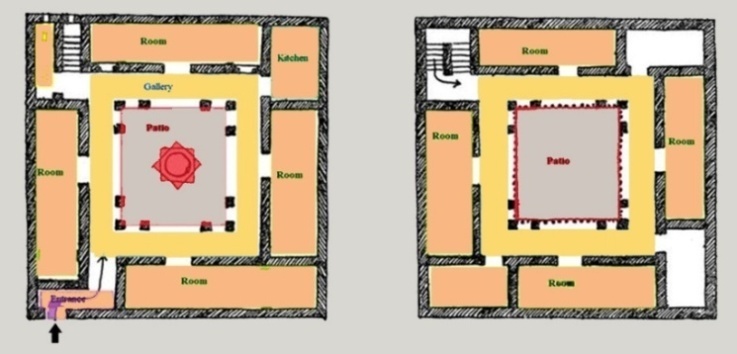 | Figure 10. The houses in traditional urban pattern |
7. Identification of House Ecological Principals
7.1. Natural Ventilation
- Usually, local architecture relies on natural ventilation, especially in homes. This technique is very beneficial in terms of heat reduction. “Indigenous people have learned to cope in this desert climate by developing a non-competitive relationship with the harsh environment. Because of the unbearable summer heat in this part of the world, the early architects of the Middle East and North Africa spent hundreds of years seeking solutions that allow local people to live in conditions as bearable as possible during the hottest days of the year”. [12]
 | Figure 11. Kasbah of MELOUKA Type VI B Image Source Author: 2003 |
7.2. Concept of Internalization
- The technique of assimilation in urban design means dispensing with the outer space and concentrating the activity in the home interior, noticeable in KSOUR architecture the acute shortage of outdoor space and this is called the urban trend. This technology is considered an important environmental factor as it works to reduce energy gains in summer days, while commitment is technically a factor for storing heat exchange between building blocks in winter days.
7.3. Control Tour
- A wind trap is an architectural tool that has been used for centuries to create natural ventilation in buildings. The function of this tower is to capture the cool breeze that prevails at a higher level above the ground and direct it into the buildings. Examples of wind traps can be found in the traditional architecture of the KSAR, where they are used for many functions, the first being monitoring the outside and ensuring security, in addition to being a lunch store and ventilation technic.
7.4. Building Materials of Ksours
- Architecture in Ksours depends on sustainable local building materials such as: bricks, clay, and palm trees. These materials are characterized by thermal insulation properties, low cost and climatic advantages, in addition to their dependence on palm trees, which is an economic factor that helps the local population..” we find urban models that are perfectly adapted to social needs, using construction techniques validated by practice and respectful of the environment”. [13]
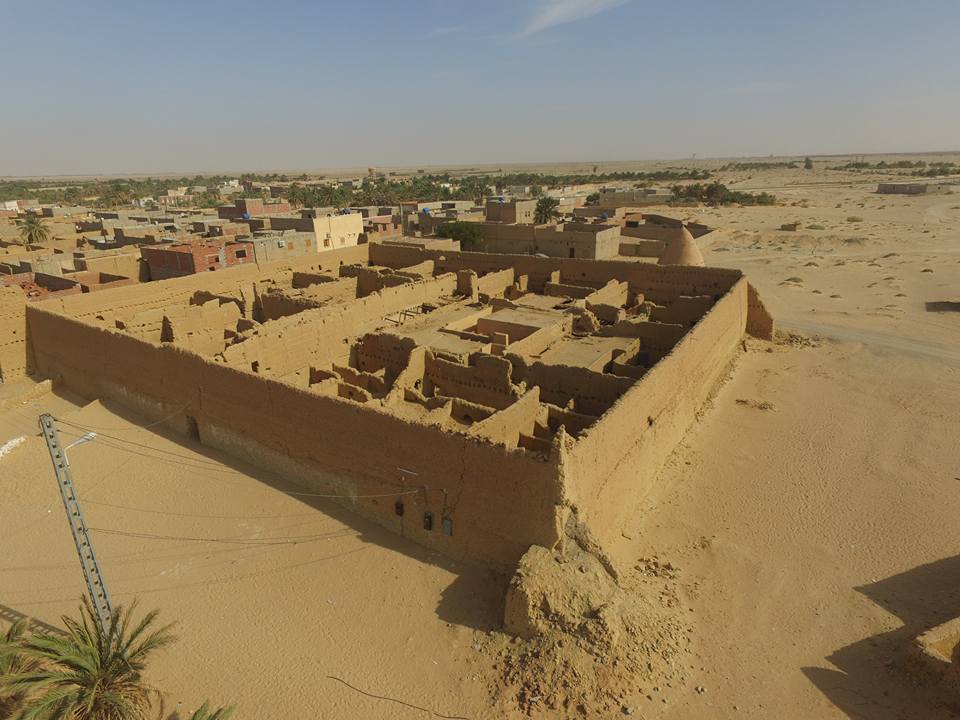 | Figure 12. Kasbah of MELOUKA |
8. Ecological Factor in Palm Grove
- “The history and the structure themselves of oases recall us this obvious fact: the nature of gardens and palm groves is artificial; to be more precise, anthropic. Surrounded by the desert, oases are usually the combination of agricultural spaces and dwellings. Their existence itself is not necessary, but the quite common shape and structure of these ecosystems in Sahara are answers, to the severe desert pedoclimatic conditions, selected and implemented by generations of gardeners”. [14]
8.1. Protection from Various Winds
- The presence of a palm grove is considered a catalyst in creating a high level of friction with the winds in the desert, and the palm groves help in breaking wind speed, changing its direction and breaking its temperature.
8.2. Sand Wind
- The sandy winds are very strong, the oasis reduces its intensity and stabilizes the sand before reaching residential areas, and the oases also benefit from the grafting process.
8.3. Dry wind
- The oasis acts as a moisture-producing agent, which helps reduce the heat island and cool the weather in the event of contact with dry winds.
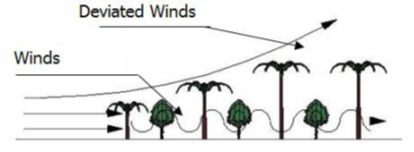 | Figure 13. Repelling process of the sandy wind by the palm grove infrastructure Image |
9. Conclusions
- The KSAR Ancient urban systems in Africa Saharan are the result of their adaptation of urban form to the parameters of the ecosystem; But these urban systems are very complex in nature; To understand the relationships between the components of the urban system it is necessary to simplify them through morphological analyzes.The KSAR are considered lessons from which we can draw many principles that can be our reference in creating the most sustainable cities of the future, among the most important of these principles:Environmental sustainability: through ecological urban design we can improve the urban climate. Joining an environment that is in harmony with the climatic conditions of a desert environment can result in joined buildings reduce heat during the day and reduce a network of dense shade. Social Sustainability: Affiliation contributes to creating an interconnected society and the preservation and consolidation of social relations. He can preserve values and identity and ultimately achieve social justice. It also provides security to reach a sustainable society.Economic sustainability: Ecological urban planning contributes to the economy and preserves land used in construction through a true appreciation of the spaces required for different jobs. In addition, it combines functions and activities and there is access to the entire population. Joining can also shorten roads.
 Abstract
Abstract Reference
Reference Full-Text PDF
Full-Text PDF Full-text HTML
Full-text HTML